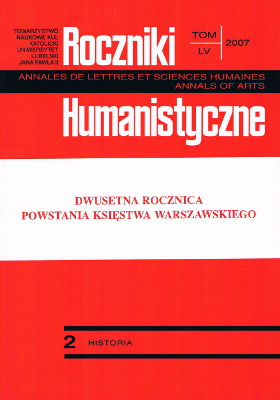The Regiment of Polish Light Cavalrymen in the Napoleonic Wars
Abstract
The regiment of Polish light cavalrymen in the Napoleonic wars is in a large brief its history. The regiment was established when Napoleon in November 1806 arrived in Polish territories, escorted by a unit of the national guard. The emperor was escorted to Warszawa by another unit of the guard, established by Wincenty Krasiński. Then Napoleon expressed his wish to make this unit the beginnings of an army accompanying his person in each place. Further parts of the paper show the participation of the light cavalry of Napoleon's guard in the Spanish, Austrian, and Russian wars, also in the battles of 1813 and 1814. The regiment of light cavalry became famous in the battle for Somosierra ravine, of Wagram and Smoleńsk. During the retreat of the Great Army from Moscow the light cavalry escorted the emperor. Then particular cavalry troops of the regiment had to repulse the superior strength of the enemy. The regiment of light cavalry was in the emperor's retinue, therefore they could rest and it was easier for them to get food, hence the unit was in good condition. In the German territories, however, the light cavalry was not spared. They took part in most battles fought by Napoleon against the coalition, both in the German and French territories. During the one hundred days the light cavalry troops, taken by Nalopeon to Elba, accompanied the emperor on his way to Paris and fought under Waterloo.
References
Bielecki R.: Somosierra, Warszawa 1989.
Tenże: Szwoleżerowie gwardii, Warszawa 1996.
Karpowicz M.: Narodziny pułku szwoleżerów. Z badań nad genezą polskiej elity wojskowej epoki napoleońskiej, „Przegląd Humanistyczny” 1984, z. 3, s.115-124.
Karpowicz M., Filipiak M.: Elita jazdy polskiej, Warszawa 1995.
Rembowski A.: Źródła do historii polskiego pułku lekkokonnych gwardii Napoleona I, Warszawa 1899.
Copyright (c) 2007 Roczniki Humanistyczne

This work is licensed under a Creative Commons Attribution-NonCommercial-NoDerivatives 4.0 International License.





